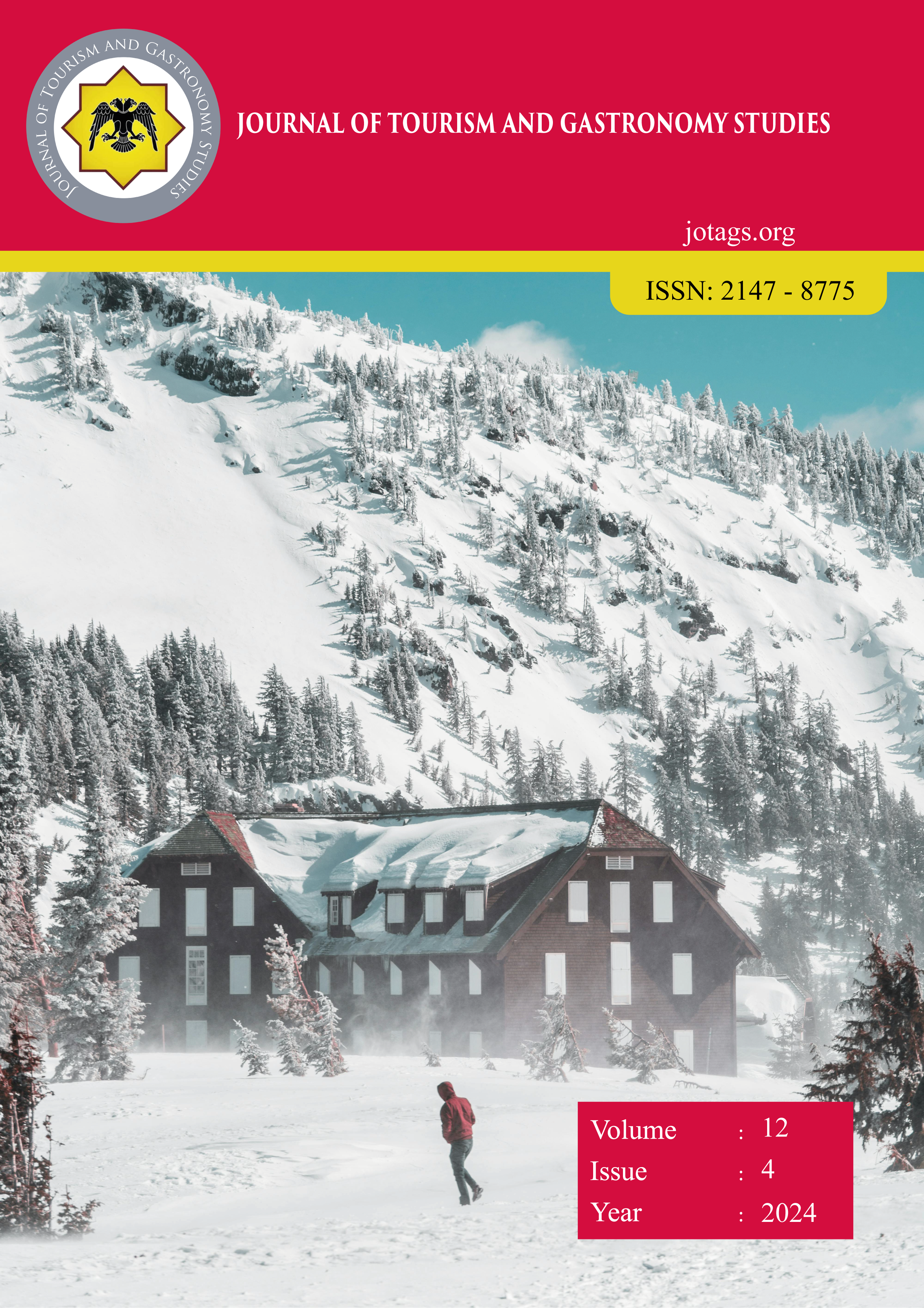Airbnblerin Mekânsal Dağılışında Etkili Olan Faktörlerin Mekânsal Analizi: Kaş-Kalkan Örneği (Spatial Analysis of Factors Influencing the Spatial Distribution of Airbnbs: The Case of Kaş-Kalkan)
DOI:
https://doi.org/10.21325/jotags.2024.1506Keywords:
Spatial analysis, Spatial statistics, Geographic Information Systems, Tourism geography, Sharing economy, Kaş, KalkanAbstract
Nowadays, emerging technologies not only transform the way people work and move in urban areas, but also change their perceptions of leisure and tourism. Shared accommodation, which was initially popular in cities, has recently become more common in tourism regions. This study aims to analyze the spatial distribution of secondary residences in Kaş, which have emerged due to the sharing economy and evolved into alternative accommodations for tourism. The study also seeks to identify the factors that influence this distribution. In the context of the research, we analyzed over 18,000 Airbnb listings within the district boundaries of Kaş using statistical and spatial methods. These methods included Kernel Density Analysis, Spatial Autocorrelation (Moran's I), Local Indicators of Spatial Association (LISA), and Network Analysis.The study findings show that in Kaş, the main factors influencing the distribution of Airbnb properties are their proximity to the sea, access to beaches and coves, accessibility to historical sites, and their proximity to the city centre.
References
Adamiak, C., Szyda, B., Dubownik, A., & García-Álvarez, D. (2019). Airbnb offer in Spain—Spatial analysis of the pattern and determinants of ıts distribution. ISPRS International Journal of Geo-Information, 8(3), 155. https://doi.org/10.3390/ijgi8030155
Adiguzel, F., Bozdogan Sert, E., Dinc, Y., Cetin, M., Gungor, S., Yuka, P., Sertkaya Dogan, O., Kaya, E., Karakaya, K., & Vural, E. (2022). Determining the relationships between climatic elements and thermal comfort and tourism activities using the tourism climate index for urban planning: a case study of Izmir Province. Theoretical and Applied Climatology, 147(3-4), 1105-1120. https://doi.org/10.1007/s00704-021-03874-9
AirDnA. (2024). Retrieved 27.09 from https://www.airdna.co/).
Akıncı, Z., & Kasalak, M. A. (2016). Sürdürülebilir turizm yönetimi açısından özel ilgi turizminin yeri ve önemi [The place and ımportance of special ınterest tourism in terms of sustainable tourism management]. Çatalhöyük Uluslararası Turizm ve Sosyal Araştırmalar Dergisi(1), 161-182. https://dergipark.org.tr/tr/pub/cutsad/issue/61052/906514
Akış, S. (1999). Sürdürülebilir turizm ve Türkiye. Anatolia: Turizm Araştırmaları Dergisi, 10(1), 36-46. https://dergipark.org.tr/tr/pub/atad/issue/53224/706669
Arınç, K. (2006). Türkiye’nin Coğrafi Bölgeleri. Cilt, Kıyı Bölgeleri, Mega Ofset Mat. Erzurum.
Arslan Ayazlar, R. (2018). Sharing economy and its reflections to tourism industry. Gaziantep University Journal of Social Sciences, 17(3), 1185-1202. https://doi.org/10.21547/jss.376826
Ayaz, N., & Türker, A. (2021). Villa tipi konaklama ünitelerinin nitelikleri: Seyahat acentaları web siteleri üzerinden bir değerlendirme. Journal of Travel and Tourism Research, 18(18), 159-178. https://dergipark.org.tr/tr/pub/ttr/issue/63499/878936
Ayhan, G., Çağlıyan, Ayşe. (2019). Geographical Analysis of summer houses by the lake hazar in terms of their location of construction (Province of Elaziğ-Turkey). Geo Journal of Tourism and Geosites, 25(2), 648-663.
Barron, K., Kung, E., & Proserpio, D. (2018, 2018). The Sharing Economy and Housing Affordability.
Baum, J. A., & Haveman, H. A. (1997). Love thy neighbor? Differentiation and agglomeration in the Manhattan hotel industry, 1898-1990. Administrative Science Quarterly, 304-338. https://doi.org/10.2307/2393922
Benítez-Aurioles, B. (2017). The role of distance in the peer-to-peer market for tourist accommodation. Tourism Economics, 24(3), 237-250. https://doi.org/10.1177/1354816617726211
Del Romero Renau, L. (2018). Touristification, sharing economies and the new geography of urban conflicts. Urban Science, 2(4), 104. https://doi.org/10.3390/urbansci2040104
Demir, E., & Emekli, G. (2021). Is Airbnb no longer a sharing economy platform? Evidence from Europe’s top 10 Airbnb destinations. Anatolia, 32(3), 470-488. https://doi.org/10.1080/13032917.2021.1890626
Doğanay, H., & Zaman, S. (2019). Türkiye Turizm Coğrafyası (Vol. 3). Pegem Akademi.
Dudás, G., Vida, G., Kovalcsik, T., & Boros, L. (2017). A socio-economic analysis of Airbnb in New York City. Regional Statistics, 7(1), 135-151. https://doi.org/10.15196/rs07108
Eckhardt, G. M., Houston, M. B., Jiang, B., Lamberton, C., Rindfleisch, A., & Zervas, G. (2019). Marketing in the Sharing Economy. Journal of Marketing, 83(5), 5-27. https://doi.org/10.1177/0022242919861929
Egan, D. J., & Nield, K. (2000). Towards a theory of intraurban hotel location. Urban studies, 37(3), 611-621.
Erel, T., Gümüş, E., & Üçüncü, O. (2014). Kalkan ve çevresinde (Antalya ili) ekonomik yapıdaki değişimler ve turizm olgusu [Changes in economic structure and tourism in Kalkan and surroundings (Antalya Province)]. Türk Coğrafya Dergisi, 0(28), 123-142. https://doi.org/10.17211/tcd.66985
Esri. (2024). Retrieved 27.09 from https://pro.arcgis.com/en/pro-app/latest/tool-reference/spatial-analyst/kernel-density.htm#:~:text=If%20Densities%20is%20chosen%2C%20the,is%20Count%20%3D%20Density%20%C3%97%20Area.
Eugenio-Martin, J. L., Cazorla-Artiles, J. M., & González-Martel, C. (2019). On the determinants of Airbnb location and its spatial distribution. Tourism Economics, 25(8), 1224-1244. https://doi.org/10.1177/1354816618825415
Gutiérrez, J., García-Palomares, J. C., Romanillos, G., & Salas-Olmedo, M. H. (2017). The eruption of Airbnb in tourist cities: Comparing spatial patterns of hotels and peer-to-peer accommodation in Barcelona. Tourism Management, 62, 278-291. https://doi.org/10.1016/j.tourman.2017.05.003
Hall, C. M., & Page, S. J. (2014). The Geography of Tourism and Recreation: Environment, Place And Space. Routledge.
Hall, C. M., Prayag, G., Safonov, A., Coles, T., Gössling, S., & Naderi Koupaei, S. (2022). Airbnb and the sharing economy. Current Issues in Tourism, 25(19), 3057-3067. https://doi.org/10.1080/13683500.2022.2122418
Harvey, D. (1989). The Condition of Postmodernity: An Enquiry into The Origins of Cultural Change. Cambridge and Oxford: Blackwell.
Kalnins, A., & Chung, W. (2004). Resource‐seeking agglomeration: a study of market entry in the lodging industry. Strategic Management Journal, 25(7), 689-699. https://doi.org/10.1002/smj.403
Karabağ, K. (2018). Özgün bir yerleşim olarak kalkan'ın tarihi ve mimari nitelikleri. Megaron, 13(2). https://doi.org/10.5505/MEGARON.2017.27147
Kaya, Ö., Toroğlu, E., & Adıgüzel, F. (2016). 2011 Genel seçimlerinde partilerin aldığı oy oranlarının ilçeler ölçeğinde mekânsal analizi [The spatial analysis of the parties voting rate on the district scale at the general election In 2011]. Coğrafya Dergisi, 0(31), 1-13. https://dergipark.org.tr/en/pub/iucografya/issue/25076/264660
Kervakıran, İ., & Çuhadar, M. (2016). Türkiye'de yabancı turist dağılımının mekansal kümelenme analizi. Journal of Recreation and Tourism Research, 3(3), 53-64.
Kervankıran, İ., & Çuhadar, M. (2017). Türkiye’de iç turizmin gelişimi ve mekânsal istatistik yöntemlerle analizi. Turizm Akademik Dergisi, 4(2), 1-18.
Keskinok, H. Ç., Şahin Güçhan, N., & N, Ö. (2005). Kalkan’ın gelişme ve koruma sorunları: tehditler, olanaklar ve çözüm önerileri. Planlama, 87.
Ki, D., & Lee, S. (2019). Spatial distribution and location characteristics of Airbnb in Seoul, Korea. Sustainability, 11(15), 4108. https://doi.org/10.3390/su11154108
Kültür ve Turizm Bakanlığı, (2023). Retrieved 21.09.2024 from https://yigm.ktb.gov.tr/TR-201131/-istatistikleri.html
Mayer, S. (2024). Airbnb statistics and host insight. Retrieved 26.09.2024 from https://www.thezebra.com/resources/home/airbnb-statistics/
Nelson, V. (2021). An İntroduction to The Geography of Tourism. Rowman & Littlefield.
O'Sullivan, D., & Unwin, D. J. (2010). Geographic information analysis. https://doi.org/10.1002/9780470549094
O’ Regan, M., & Choe, J. (2017). Airbnb and cultural capitalism: enclosure and control within the sharing economy. Anatolia, 28(2), 163-172. https://doi.org/10.1080/13032917.2017.1283634
Ojeda, A. B., & Kieffer, M. (2020). Touristification. Empty concept or element of analysis in tourism geography? Geoforum, 115, 143-145. https://doi.org/10.1016/j.geoforum.2020.06.021
Özdemi̇r, G., & Çelebi̇, D. (2018). Paylaşım ekonomisi: Airbnb Örneği. ISGUC The Journal of Industrial Relations and Human Resources, 25-38. https://doi.org/10.4026/isguc.431016
Özgüç, N. (2007). Turizm Coğrafyası. İstanbul: Çantay Kitabevi.
Parente, R. C., Geleilate, J.-M. G., & Rong, K. (2018). The sharing economy globalization phenomenon: a research agenda. Journal of International Management, 24(1), 52-64. https://doi.org/10.1016/j.intman.2017.10.001
Rabiei-Dastjerdi, H., McArdle, G., & Hynes, W. (2022). Which came first, the gentrification or the Airbnb? Identifying spatial patterns of neighbourhood change using Airbnb data. Habitat International, 125, 102582. https://doi.org/10.1016/j.habitatint.2022.102582
Rauch, D. E., & Schleicher, D. (2015). Like Uber, but for local government law: the future of local regulation of the sharing economy. Ohio St. LJ, 76, 901.
Schoenbaum, N. (2016). Gender and the sharing economy. Fordham Urb. LJ, 43, 1023.
Shoval, N. (2006). The geography of hotels in cities: An empirical validation of a forgotten model. Tourism Geographies, 8(1), 56-75. https://doi.org/10.1080/14616680500392499
Sun, S., Wang, X., & Hu, M. (2022). Spatial distribution of Airbnb and its influencing factors: A case study of Suzhou, China. Applied Geography, 139, 102641. https://doi.org/10.1016/j.apgeog.2022.102641
Toffler, A. (2021). Future Shock. Random House.
Urry, J. (2007). Mekanları Tüketmek. Ayrıntı Yayınları.
Urtasun, A., & Gutiérrez, I. (2006). Hotel location in tourism cities. Annals of Tourism Research, 33(2), 382-402. https://doi.org/10.1016/j.annals.2005.12.008
Xu, F., Hu, M., La, L., Wang, J., & Huang, C. (2020). The influence of neighbourhood environment on Airbnb: a geographically weighed regression analysis. Tourism Geographies, 22(1), 192-209. https://doi.org/10.1080/14616688.2019.1586987
Yang, Y., Wong, K. K. F., & Wang, T. (2012). How do hotels choose their location? Evidence from hotels in Beijing. International Journal of Hospitality Management, 31(3), 675-685. https://doi.org/10.1016/j.ijhm.2011.09.003
Zhang, Z., & Chen, R. J. C. (2019). Assessing Airbnb logistics in cities: Geographic Information System and Convenience Theory. Sustainability, 11(9), 2462. https://doi.org/10.3390/su11092462
Zhou, X. (2023). The sharing economy ıncreases social network activity and thus the ability to realize traffic. Advances in Economics, Management and Political Sciences, 61(1), 87-95. https://doi.org/10.54254/2754-1169/61/20231042
Zoğal, V., & Emekli, G. (2024). Muğla’da Airbnb ilanlarının coğrafi boyutları ve mekânsal özellikleri. Coğrafi Bilimler Dergisi, 22(1), 44-70. https://doi.org/10.33688/aucbd.1406417
Downloads
Published
How to Cite
Issue
Section
License
Copyright (c) 2024 Journal of Tourism & Gastronomy Studies

This work is licensed under a Creative Commons Attribution-NonCommercial 4.0 International License.








